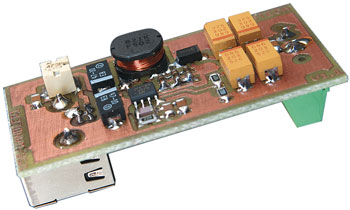USB Converter

Does this sound familiar: you buy a small piece of equipment, such as a programming & debugging interface for a microcontroller, and you have to use a clunky AC wall adapter to supply it with power? It’s even worse when you’re travelling and there’s no mains socket anywhere in sight. Of course, you can use the USB bus directly as a power source if the supply voltage is 5 V. If you need a higher voltage, you can use the USB converter described here. This small switch-mode step-up converter can generate an output voltage of up to 15 V with a maximum output current of 150 mA.
This is a MEMBER ONLY article. You need a subscription to read this article.
- Access to Elektor archive and 5,000+ Gerber files
- Receive up to 8 magazines per year (digital and/or paper)
- 10% discount in the Elektor store
Available from €4.95 per month.
What is Members Only
Elektor is committed to providing high-quality content on electronics, catering to tens of thousands of paying members. As part of this commitment, Elektor has launched Premium, an initiative that offers exclusive online articles to members sometimes even before they appear in the magazine.
Every day, members can access in-depth articles that showcase the best of Elektor's premium content.
This initiative aims to reward members with early access. Once logged in, members can easily enjoy this exclusive content and engage in discussions about featured projects. While Premium adds to the existing resources available, Elektor will continue to provide a wealth of free information.
Join the Elektor community today to take advantage of Premium and other benefits!
Materials
Component list
(for Uo=9 V)
Resistors: (all SMD 1206)
R1 = 1 Ohm
R2 = 1 Ohm
R3 = 1 Ohm
R4 = 220k
R5 = 82k
R6 = 10k
Capacitors: (all SMD 1206)
C1 = 100n
C2 = 2n2
C3 = 22p
C4 = 100n
C5 = 1n5
Tantalum capacitors: (all SMD 7343)
C6 = 68µ/20 V
C7 = 68µ/20 V
C8 = 68µ/20 V
C9 = 47µ/16 V
C10 = 47µ/16 V
C11 = 68µ/20 V
Inductors:
L1 = 820 µH (SMD CD105)
L2 = 47 µH (SMD 2220)
Semiconductors:
D1 = SK34SMD Schottky
IC1 = LM3578AM (SMD SO8)
Stecker:
K1 = 2-way PCB terminal brlock, lead pitch 5mm (optionnal)
K2 = USB-B-connector
Download for free the PCB layout (070119-1.pdf)



Discussion (0 comments)